Top 31 Prospects: Tampa Bay Rays
Below is an analysis of the prospects in the Tampa Bay Rays farm system. Scouting reports are compiled with information provided by industry sources as well as from my own observations. The KATOH statistical projections, probable-outcome graphs, and (further down) Mahalanobis comps have been provided by Chris Mitchell. For more information on the 20-80 scouting scale by which all of my prospect content is governed you can click here. For further explanation of the merits and drawbacks of Future Value, read this. -Eric Longenhagen
The KATOH projection system uses minor-league data and Baseball America prospect rankings to forecast future performance in the major leagues. For each player, KATOH produces a WAR forecast for his first six years in the major leagues. There are drawbacks to scouting the stat line, so take these projections with a grain of salt. Due to their purely objective nature, the projections here can be useful in identifying prospects who might be overlooked or overrated. Due to sample-size concerns, only players with at least 200 minor-league plate appearances or batters faced last season have received projections. -Chris Mitchell
Other Lists
NL West (ARI, COL, LAD, SD, SF)
AL Central (CHW, CLE, DET, KC, MIN)
NL Central (CHC, CIN, PIT, MIL, StL)
NL East (ATL, MIA, NYM, PHI, WAS)
AL East (BAL, BOS, NYY, TB, TOR)
| Rk | Name | Age | Highest Level | Position | ETA | FV |
|---|---|---|---|---|---|---|
| 1 | Willy Adames | 21 | AA | SS | 2018 | 60 |
| 2 | Brent Honeywell | 21 | AA | RHP | 2018 | 55 |
| 3 | Jose DeLeon | 24 | MLB | RHP | 2016 | 55 |
| 4 | Jesus Sanchez | 19 | R | OF | 2020 | 50 |
| 5 | Jake Bauers | 21 | AA | 1B | 2018 | 45 |
| 6 | Josh Lowe | 19 | R | CF | 2021 | 45 |
| 7 | Chih-Wei Hu | 23 | AAA | RHP | 2018 | 45 |
| 8 | Lucius Fox | 19 | A | SS | 2021 | 45 |
| 9 | Casey Gillaspie | 24 | AAA | 1B | 2017 | 45 |
| 10 | Adrian Rondon | 18 | R | 3B | 2021 | 45 |
| 11 | Garrett Whitley | 20 | A- | OF | 2021 | 45 |
| 12 | Daniel Robertson | 23 | AAA | UTIL | 2017 | 40 |
| 13 | Austin Franklin | 19 | R | RHP | 2021 | 40 |
| 14 | Justin Williams | 21 | AA | OF | 2019 | 40 |
| 15 | Jacob Faria | 23 | AAA | RHP | 2017 | 40 |
| 16 | Ryne Stanek | 25 | AAA | RHP | 2017 | 40 |
| 17 | Jake Fraley | 21 | A- | OF | 2019 | 40 |
| 18 | Diego Castillo | 23 | R | RHP | 2017 | 40 |
| 19 | Chris Betts | 20 | A- | C | 2020 | 40 |
| 20 | Resly Linares | 19 | R | LHP | 2020 | 40 |
| 21 | Michael Santos | 21 | A | RHP | 2019 | 40 |
| 22 | Kevin Padlo | 20 | A | 3B | 2020 | 40 |
| 23 | Taylor Guerrieri | 24 | AA | RHP | 2017 | 40 |
| 24 | Hunter Wood | 23 | AA | RHP | 2017 | 40 |
| 25 | Jaime Schultz | 25 | AAA | RHP | 2017 | 40 |
| 26 | Greg Harris | 22 | AAA | RHP | 2018 | 40 |
| 27 | David Rodriguez | 21 | R | C | 2019 | 40 |
| 28 | Jose Alvarado | 21 | A+ | LHP | 2017 | 40 |
| 29 | Brandon Koch | 23 | R | RHP | 2018 | 40 |
| 30 | Ryan Boldt | 22 | A- | CF | 2019 | 40 |
| 31 | Jhonleider Salinas | 21 | R | RHP | 2020 | 40 |
60 FV Prospects
| Age | 21 | Height | 6’1 | Weight | 180 | Bat/Throw | R/R |
|---|
| Hit | Raw Power | Game Power | Run | Fielding | Throw |
|---|---|---|---|---|---|
| 40/55 | 55/60 | 40/55 | 45/40 | 40/45 | 60/60 |
Relevant/Interesting Metrics
Slashed .270/.370/.430 as a 20-year-old at Double-A.
Scouting Report
The barrel-chested Adames might ordinarily project to move off shortstop given his build, but it seems to me that Tampa has a rather liberal organizational philosophy about what constitutes a viable defensive shortstop and Adames isn’t going to be any more offensive there than aging Asdrubal Cabrera and Yunel Escobar have been in recent years.
If Adames does have to move off of shortstop (I have a future 50 on him there and he has plenty of arm), then he’s probably grown into enough power to profile anywhere he moves. He has good feel for contact and a bat path that should produce both it and power. If his body matures in the Goldilocks Zone and, when he’s 25 or so, he’s added power but simultaneously retained the physical agility to stay at shortstop, he’ll be among the growing collection of young Uber Shortstops we all get to watch for the next decade. The result, in that case: a high-end makeup, franchise-cornerstone type of player. Adames was acquired from Detroit in the David Price trade.
KATOH+ Projection for first six years: 10.4 WAR

55 FV Prospects
| Age | 22 | Height | 6’2 | Weight | 180 | Bat/Throw | R/R |
|---|
| Fastball | Curveball | Changeup | Splitter | Cutter | Command |
|---|---|---|---|---|---|
| 60/60 | 40/40 | 55/60 | 60/60 | 40/45 | 45/55 |
Relevant/Interesting Metrics
Recorded strikeout and walk rates of 23% and 6%, respectively, at Double-A.
Scouting Report
Honeywell’s deep, unique collection of pitches is bolstered by artistic sequencing, and he essentially never has to pitch off of his fastball (though he could if he wanted to, I’ve seen it up to 98) because he always has new looks to show hitters. The best of these is a cutter and changeup. The screwball (in the 79-82 mph range while the changeup is usually a little harder than that) is more than a gimmick and can miss bats. Like chocolate cake, however, it’s best in moderation — not only because it arguably adds to the violence already inherent in Honeywell’s delivery, but because (it seemed to me, during Fall League looks) that good hitters are able to recognize it after seeing it multiple times in the same at-bat. He also has a loopy, below-average curveball. The effort in the delivery and Honeywell’s six-week DL stint last summer have some concerned about injuries, but there’s a chance for three plus pitches and above-average command here.
KATOH+ Projection for first six years: 5.7 WAR
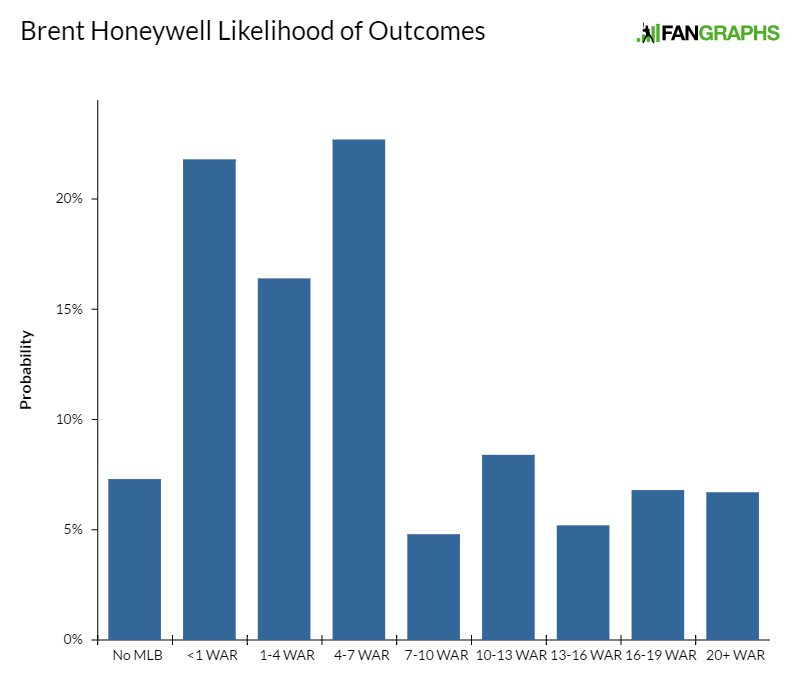
| Age | 24 | Height | 6’2 | Weight | 190 | Bat/Throw | R/R |
|---|
| Fastball | Slider | Changeup | Command |
|---|---|---|---|
| 55/55 | 50/50 | 55/60 | 50/60 |
Relevant/Interesting Metrics
Posted 0.94 WHIP in hitter-friendly Pacific Coast League.
Scouting Report
Undrafted out of Puerto Rico as a high schooler, De Leon matriculated to Southern and began missing bats immediately. He led the SWAC in strikeouts as a sophomore, but his body, delivery and stuff backed up as a junior. He signed for just $35,000 as a 24th rounder and had a promising, if rocky, pro debut in 2013. The next year, things clicked: De Leon improved his conditioning and strike-throwing and began to experience rousing success. He’s advanced through two minor-league levels in each of the last three years, culminating in a three-start run at Triple-A this past season, during which DeLeon struck out 33 hitters in 21 innings and didn’t walk a single batter. He made his big-league debut after that stretch.
De Leon has mid-rotation starter’s stuff. The fastball sits 90-93 and will touch 95 with life. De Leon’s drop-and-drive delivery sucks plane out of the fastball, and he’s fly-ball prone when he’s working up in the zone. He has above-average fastball command that projects to plus and mitigates concerns about the fastball’s context-free effectiveness. His best secondary pitch is a changeup that, too, projects to plus if it isn’t already there. His low-80s slider is an average offering and only consistently effective when he’s locating it just off the plate to his glove side. De Leon didn’t do this in his brief major-league stint, but it was a significant aspect of his success at Triple-A and I expect to see improved slider location in 2017. I think De Leon will be an above-average big-league starter.
KATOH+ Projection for first six years: 8.0 WAR

50 FV Prospects
| Age | 19 | Height | 6’2 | Weight | 185 | Bat/Throw | L/R |
|---|
| Hit | Raw Power | Game Power | Run | Fielding | Throw |
|---|---|---|---|---|---|
| 20/50 | 50/60 | 30/55 | 50/45 | 40/50 | 60/60 |
Relevant/Interesting Metrics
Slashed .330/.350/.550 in 2016.
Scouting Report
While impatient at the plate, Sanchez has star-level offensive tools and a chance to remain at a premium defensive position. He’s good-bodied and projectable and already has enough raw power that he accidentally threatens opposite-field fences with well-hit balls. He has plus bat speed, generates big extension through contact, and projects to have plus raw power at maturity. Despite some effort to the swing and a very aggressive approach, Sanchez has shown good bat control and has the physical tools to hit and hit for power, though he’d do well to tone down his tendency to take early-count hacks.
Sanchez is an average runner (above underway) and there’s not a consensus among scouts about his long-term ability to stay in center field. Some think his feel for the position will improve to the point where he’s a viable defender there despite lacking top end speed; others think the body grows into right field.
The risk profile here is sizable because of the somewhat unstable defensive profile and because Sanchez doesn’t exactly have a plan at the plate right now. But there’s a chance for five average or better tools if things pan out just right, and there just aren’t many other prospects like that in the minors. He’s already a Boras client.
KATOH+ Projection for first six years: 0.6 WAR
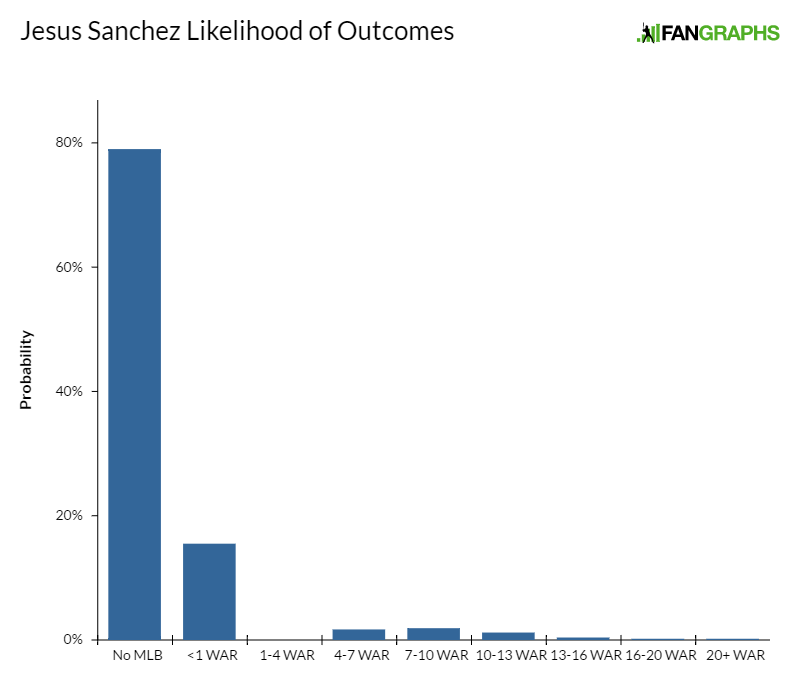
45 FV Prospects
| Age | 21 | Height | 6’1 | Weight | 195 | Bat/Throw | L/L |
|---|
| Hit | Raw Power | Game Power | Run | Fielding | Throw |
|---|---|---|---|---|---|
| 45/60 | 55/55 | 40/45 | 45/40 | 45/55 | 50/50 |
Relevant/Interesting Metrics
Recorded 13% walk rate, 15% strikeout rate, and .146 ISO at Double-A.
Scouting Report
Bauers was an advanced Southern California high-school hitting prospect but had no clear position and lacked the physical projection that is typical for high-end corner-outfield or first-base prospects. That’s largely why he lasted until the seventh round of the 2013 draft, where he was picked by San Diego. His first full pro season began with an aggressive assignment in the Midwest League and he excelled, hitting .296/.376/.414 there at age 18. He was traded to Tampa that offseason as part of the Wil Myers deal. Bauers has continued to hit and reach base consistently, always young for his level, though producing only modest power.
Scouts unanimously think Bauers is going to hit in the big leagues. He’s very smooth and relaxed in the box, has a mature approach, makes adjustments to breaking balls and tracks pitches well. His bat speed and bat control are solid, too, and he projects as a plus hitter overall. The power remains a question mark. Bauers has above-average raw power and makes opposing pitchers pay for making mistakes up and in, but he doesn’t have the monster, all-fields raw power typically associated with first-base and corner-outfield prospects. (Bauers hit four oppo homers in 2016, but Montgomery’s left-field fence is only about 310 feet from home plate, closer than the Crawford Boxes in Houston.)
At a thick 6-foot-1, there’s probably not any more power coming. There are those who feel the combination of OBP and copious doubles will be enough for Bauers to profile as a good everyday player, no matter where his ultimate defensive home lies. (I prefer him at first, where he could be a 55 glove at peak.) Others think it’s more of a fringe profile. And then there are scouts who have seen him struggle against lefties and think he’s more of a platoon bat. The track record of offensive success here is very strong, and I believe Bauers is going to be a steady big leaguer of some kind, with a chance to be an average everyday player. That said, his upside is capped by the lack of power output. If he ends up as more than that it will be because of his secondary skills.
KATOH+ Projection for first six years: 9.9 WAR

| Age | 19 | Height | 6’4 | Weight | 190 | Bat/Throw | L/R |
|---|
| Hit | Raw Power | Game Power | Run | Fielding | Throw |
|---|---|---|---|---|---|
| 20/45 | 50/60 | 20/55 | 60/60 | 40/50 | 60/60 |
Relevant/Interesting Metrics
Basically none. Played less than 30 games at each of two stops.
Scouting Report
An athletic, two-way prospect, Lowe had some of the 2016 draft’s more ethereal upside with plus straight-line speed, plus raw power projection, and a plus arm. Physically, he looks as though someone cloned Brad Zimmer and he takes similarly efficient, earth-eating strides in center field, which is where I have him projected after he flopped at third base over the summer.
As is typical for most two-way prep prospects, Lowe is a bit raw in various facets of baseball. He’s new to center field but has the speed to stay there once his routes get polished up with reps. When I saw him in the fall, Lowe had a tendency to open up his hips early, get pull-happy, and struggle to cover the outer half of the plate (something that’s probably correctable). He also has natural swing and miss due to lever length (something that isn’t). Nevertheless, his power on contact is strong and, even if he always whiffs a lot, the power/speed/defensive foundation of his profile is still very favorable. And if he does learn to hit, he’s a potential star.
KATOH+ Projection for first six years: 2.8 WAR
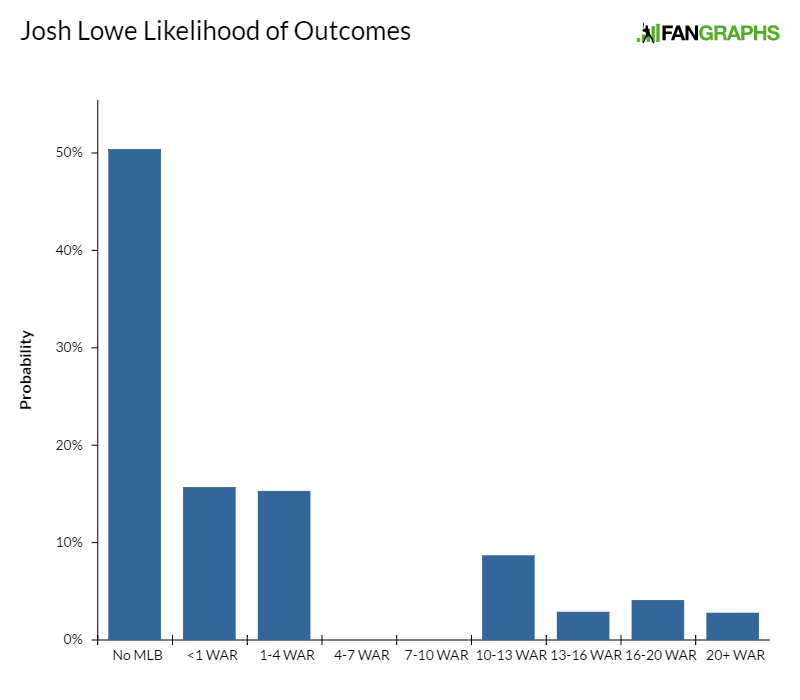
| Age | 23 | Height | 6’1 | Weight | 209 | Bat/Throw | R/R |
|---|
| Fastball | Curveball | Changeup | Splitter | Cutter | Command |
|---|---|---|---|---|---|
| 50/50 | 45/45 | 60/60 | 45/45 | 50/55 | 45/50 |
Relevant/Interesting Metrics
Career 2.74 minor-league ERA.
Scouting Report
Hu was 94-97 with bat-missing movement in his abbreviated Futures Game appearance but sits more 89-94 as a starter. His plus changeup, which positively evaporates as it reaches the plate, was arguably the dirtiest pitch at that event, with identical fastball arm speed but less velo separation than is usual. He also has a hard, upper-80s cutter, usually 86-89, which has been a point of developmental emphasis for Hu this spring. Rounding out the repertoire are a palmball and fringe curve, both of which operate as changes of pace off of the other offspeed and breaking ball, respectively.
Though he clearly has a starter’s toolkit of pitches with which to work, there are those who think Hu’s ultimate role will be in the bullpen, as his delivery has some effort and lacks consistent, efficient use of his lower half. Others see a stocky, strong build capable of handling a heavy workload. I lean toward the latter group and think Hu has a good chance to be a league-average starter at peak, though acknowledge there’s a chance he ends up in a relief role, where he could be dominant based on what we’ve seen from him in short stints in the past.
KATOH+ Projection for first six years: 1.5 WAR

| Age | 19 | Height | 6’1 | Weight | 175 | Bat/Throw | S/R |
|---|
| Hit | Raw Power | Game Power | Run | Fielding | Throw |
|---|---|---|---|---|---|
| 20/55 | 30/40 | 20/40 | 70/70 | 40/55 | 55/55 |
Relevant/Interesting Metrics
Produced just .582 OPS at Low-A.
Scouting Report
Fox was born in the Bahamas and then came to the U.S. to play high-school baseball at American Heritage in Florida. He reclassified as an international amateur ahead of the deadline. (International free agency was, at the time, more lucrative than the wage-suppressing draft. Now, both are disasters created by a selfish and short-sighted player’s union and greedy sect of owners, but I digress.) He got $6 million from San Francisco instead of the 1.4-1.7 million he likely would have gotten in the draft.
The Giants, very aggressively, sent him directly to full-season ball in Augusta and Fox flopped. He fouled a ball off of his foot and suffered a bone bruise, through which he attempted to play, a week or so before he was traded to Tampa in the Matt Moore deal. Tampa wasn’t aware of the issue and there was talk of them receiving additional compensation in that deal but nothing materialized. Fox sat out the rest of the season.
The talent — which led to Fox ranking third on the FanGraphs IFA board and second on my own pref list for ESPN at the time — is all still here. Fox is an exceptional quick-twitch athlete and plus runner, has flashy but inconsistent actions at short, good bat speed, some barrel control, and a frame that should strengthen with age. Fox has the physical capability to one day play a good defensive shortstop and also do some damage with the bat near the top of a lineup. He’s a potential star who had quickly fallen out of favor with his previous org. This is exactly the kind of player Tampa should be trying to acquire via trade, because they have no way to acquire it via free agency.
KATOH+ Projection for first six years: 1.0 WAR
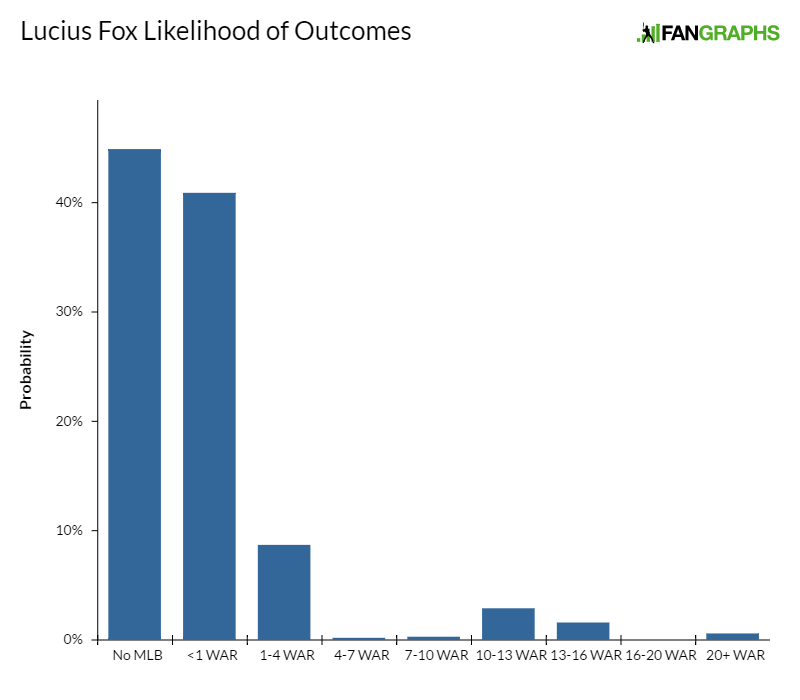
| Age | 24 | Height | 6’4 | Weight | 238 | Bat/Throw | S/L |
|---|
| Hit | Raw Power | Game Power | Run | Fielding | Throw |
|---|---|---|---|---|---|
| 40/45 | 60/60 | 45/50 | 20/20 | 40/45 | 40/40 |
Relevant/Interesting Metrics
Slashed .284/.388/.480 in 2016 between Double- and Triple-A.
Scouting Report
Those who are influenced by aesthetics {author sheepishly raises hand} may have a more difficult time evaluating Gillaspie, who had an effective season in 2016 at the upper levels (mostly as a 23-year old at Double-A) but has some mechanical idiosyncrasies. Gillaspie lacks bat speed and has shortened his load, especially as a right-handed hitter, since college, presumably as a way to artificially shorten his swing. While most hitters draw their hands back like the string of a bow before they fire back toward the ball, Gillaspie’s hands just kind of hang out in one spot before his back elbow drops and he drives his hands toward the ball from a basically idle position. He’s strong enough to make this work, though it limits his bat control and some scouts are concerned about his ability to catch velocity up in the zone this way.
There’s inarguable raw power and patience here, but questions remain about how much Gillaspie is going to hit. As a first-base-only prospect, that makes for a relatively unstable profile. He might require an adjustment at some point and, while Gillaspie is a below-average athlete, he’s already had to make some and shown that he can. He projects as a power/patience platoon option for me.
KATOH+ Projection for first six years: 3.8 WAR
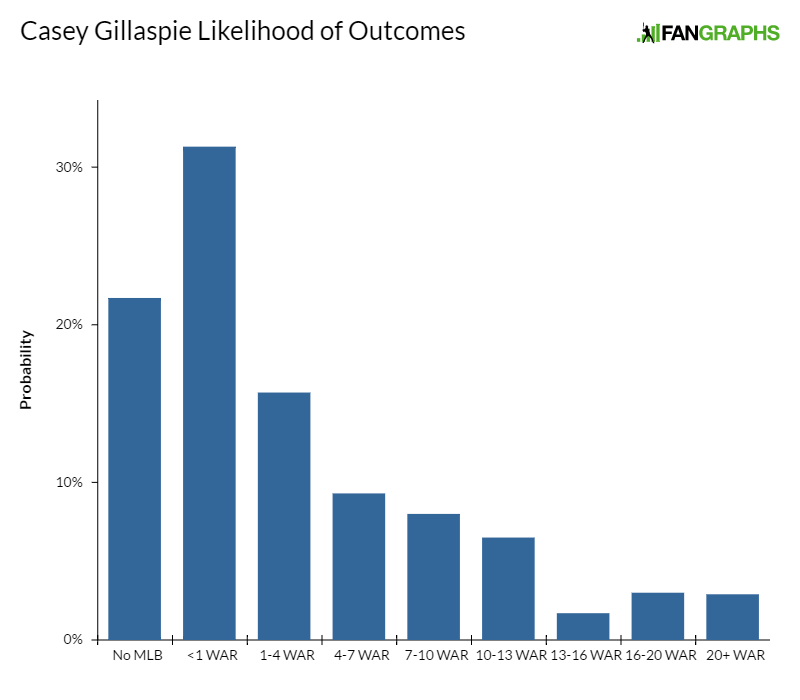
| Age | 18 | Height | 6’1 | Weight | 190 | Bat/Throw | R/R |
|---|
| Hit | Raw Power | Game Power | Run | Fielding | Throw |
|---|---|---|---|---|---|
| 20/40 | 55/60 | 30/50 | 40/30 | 40/50 | 55/55 |
Relevant/Interesting Metrics
Slashed .250/.300/.430 in Appy League, with 19 extra-base hits in 52 games.
Scouting Report
Rondon’s prodigious physical skills are undercut by an overaggressive approach and a few mechanical warts that have him swinging and missing far too often than will be acceptable at his likely future defensive home. He signed as a shortstop for just shy of $3 million in 2014, and his pro debut in 2015 was a disaster — not just statistically but also physically, as Rondon’s body went backward quickly. While he’s tightened things back up a bit, Rondon is still thick-keistered, heavy-footed, and projects over to third base at maturity.
His hand acceleration; loose, whippy extension through contact; and wrist/hand strength are all spectacular. This is one of those prospects whose contact has a unique sonic quality that you can feel in your chest. There’s 70 bat speed here and a bat path capable of producing both contact and power and surprising barrel control. But Rondon loads his hands so deep and so high that it’s unlikely he’ll ever make even an average amount of contact without significant mechanical work, and he sometimes overswings. It’s easy to see why this kid got so much money, but he’s a very volatile prospect. He has yet to turn 19 and I still think there’s a chance adjustments can be made to unlock what is one of the more explosive raw bats in the lower minors.
KATOH+ Projection for first six years: 0.8 WAR

| Age | 20 | Height | 6’0 | Weight | 199 | Bat/Throw | R/R |
|---|
| Hit | Raw Power | Game Power | Run | Fielding | Throw |
|---|---|---|---|---|---|
| 20/40 | 55/60 | 20/50 | 60/60 | 40/50 | 55/55 |
Relevant/Interesting Metrics
Slashed .266/.356/.379, recorded 26% strikeout rate at short-season Hudson Valley.
Scouting Report
Whitley was a tough prospect to evaluate as an amateur and remains so, as his 2016 pro debut was slowed by injury and of mixed quality when he was healthy. Whitley played high-school ball in upstate New York — not exactly a baseball hot bed — and wasn’t a mainstay on prep showcases, so barely anyone saw him hit against elite prep pitching (Whitley went 0-for-2 with a hit-by-pitch against then-junior Ian Anderson, who was 88-91, that spring) ahead of the draft. There was uncertainty about how Whitley would adjust to pro pitching, but everyone saw the bat speed (arguably a 7), wheels, power, and what looked like a good baseball body. Those who scouted Mike Trout as a high-school senior were faced with similar circumstances. Former Arizona GM Dave Stewart came to see Whitley in person ahead of the draft, which I assume means he was, at one point, considered at 1-1 in 2015. He went 13 to Tampa.
As I stated in the Lucius Fox comments, this is the kind of talent that makes sense for Tampa to target when available because he might become the type of player whom the club can’t afford on the open market. So far it has been slow going for Whitley, who struggled with a hamstring injury in the spring and then with NYPL pitching later in the summer. Scouts are questioning his breaking-ball recognition, bat path, and bat control now. When I saw him in the fall during instructs, the physical tools were intact and he was tracking pitches pretty well, but I was surprised at the way his body had begun to fill out. Whitley remains a boom-or-bust prospect. If he’s able to show substantive adjustments in 2017, it will be an excellent sign for his future.
KATOH+ Projection for first six years: 0.6 WAR

40 FV Prospects
| Age | 23 | Height | 6’0 | Weight | 190 | Bat/Throw | R/R |
|---|
| Hit | Raw Power | Game Power | Run | Fielding | Throw |
|---|---|---|---|---|---|
| 50/55 | 45/45 | 30/40 | 40/40 | 45/45 | 55/55 |
Relevant/Interesting Metrics
Has recorded just season with slugging percentage over .407 — as part of Cal League back in 2014.
Scouting Report
Robertson epitomizes what I believe to be a very inclusive organizational philosophy about what constitutes a viable defensive shortstop. He is a 40 runner with marginal athleticism, but Robertson’s instincts and arm strength allow him to just pass at short if you’re Gore Vidal, but he’s a second or third baseman if you’re Will Buckley.
And for scouts who fall into the latter category, Robertson’s bat is a bit of an issue. He lacks the power to profile at either spot everyday, though he does have good bat-to-ball skills and a terrific feel for the strike zone. He profiles as a bat-first utility man for me, one who plays shortstop if the situation is emergent and only because batted-ball data is so good.
KATOH+ Projection for first six years: 3.8 WAR

| Age | 19 | Height | 6’3 | Weight | 215 | Bat/Throw | R/R |
|---|
| Fastball | Curveball | Changeup | Command |
|---|---|---|---|
| 50/55 | 50/55 | 40/50 | 40/50 |
Relevant/Interesting Metrics
Allowed no homers in 43 pro innings after signing.
Scouting Report
I saw Franklin in January of 2016 at a season kickoff event in Mesa. He was 86-92 with sink and flashing an above-average curveball. He added velocity throughout the spring and was touching 95 ahead of the draft. He has a sturdy pitcher’s body (perhaps less projectable than the typical high schooler) with a strong lower half and short torso. His delivery is simple and repeatable, and he has a changeup-friendly arm action. It’s relatively easy to project No. 4 starter upside here without getting too crazy about the command or changeup. If either of those outgrow my forecast, he could be more than that.
| Age | 21 | Height | 6’2 | Weight | 215 | Bat/Throw | L/R |
|---|
| Hit | Raw Power | Game Power | Run | Fielding | Throw |
|---|---|---|---|---|---|
| 40/55 | 60/60 | 30/40 | 40/40 | 45/50 | 50/50 |
Relevant/Interesting Metrics
Has recorded just 22 home runs in four pro seasons, but nearly half of them (10) in 2016.
Scouting Report
A physical beast, Williams got his feet wet at Double-A last year at age 21. He was bad there but hit at High-A before his promotion. Williams has plus bat speed and raw power, but his swing drives the ball down into the ground. He’s a very aggressive hitter and his manic hitting mannerisms complicate a swing that could easily rely solely on his quick, strong hands and be successful. If mechanical adjustments are made that allow Williams to get to his raw power in games, he’ll instantly become a potential everyday player, but he doesn’t run well enough to be considered for center field or fourth-outfielder duty so it’s imperative something changes here. He has terrific makeup and is still just 21, so there’s time for it.
KATOH+ Projection for first six years: 1.8 WAR
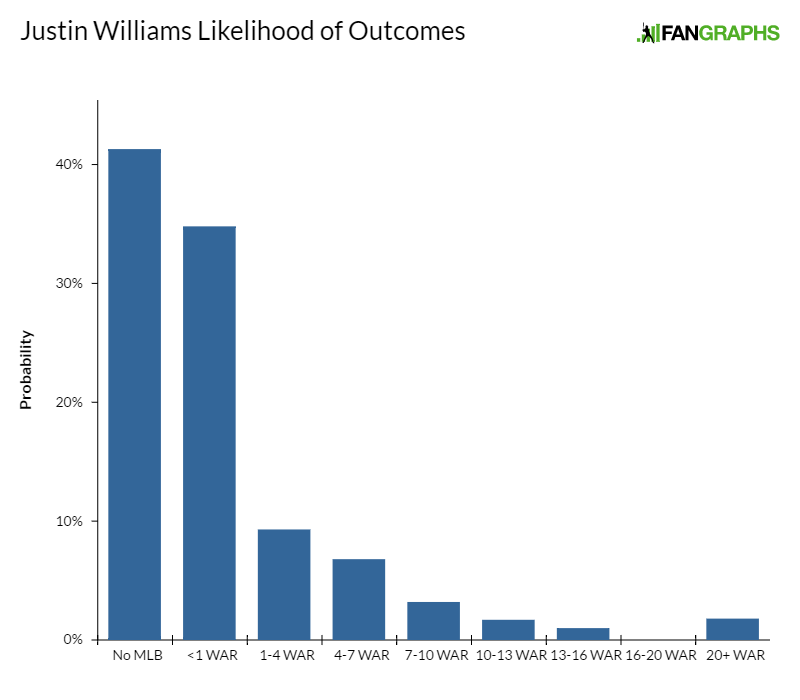
| Age | 23 | Height | 6’4 | Weight | 175 | Bat/Throw | R/R |
|---|
| Fastball | Slider | Curveball | Changeup | Command |
|---|---|---|---|---|
| 55/55 | 40/40 | 40/45 | 60/60 | 40/45 |
Relevant/Interesting Metrics
Recorded 157 strikeouts and 68 walks over 151 innings at Double- and Triple-A.
Scouting Report
A deceptive changeup artist, Faria hides the ball for a long time before his quick arm suddenly appears from behind his head. His vertical arm slot allows him to work downhill with an average fastball, and the deception in his delivery lets him slip that fastball past hitters at the letters despite modest velocity. He has a plus changeup, too. When combined with his ability to pitch effectively north and south with his fastball, Faria has a chance to goof with hitters’ eye level very effectively. He has 40 control, though, and only does so accidentally right now.
Faria’s arm slot makes it hard for him to work east and west, and he has two fringe breaking balls that, given his age, aren’t likely to progress very much. If one of them takes a half-step forward and so does the command, Faria could be a solid-average starter. He’s more likely a No. 5 or, if Faria’s command keeps trending in the direction it has been since 2015, perhaps a reliever.
KATOH+ Projection for first six years: 3.0 WAR
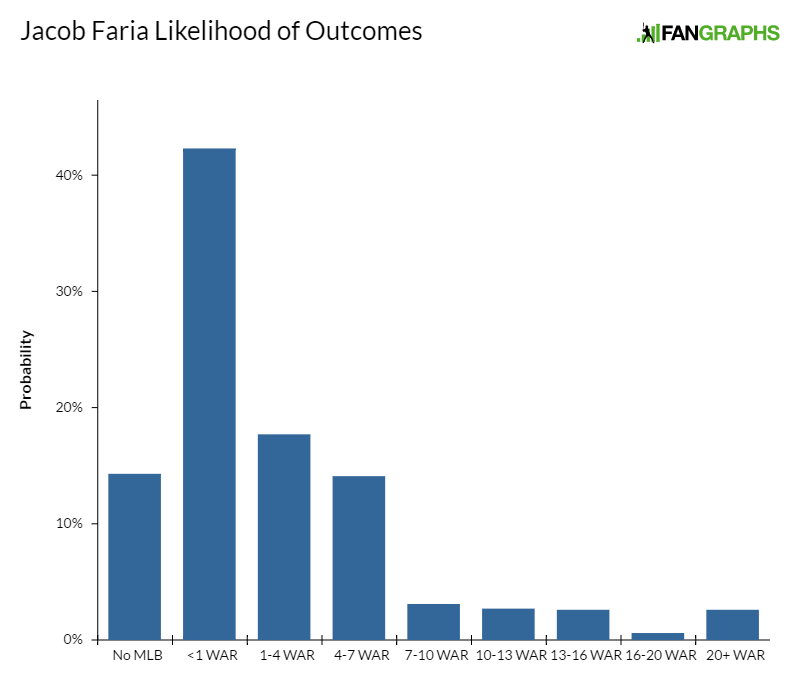
| Age | 25 | Height | 6’4 | Weight | 180 | Bat/Throw | R/R |
|---|
| Fastball | Slider | Curveball | Command |
|---|---|---|---|
| 80/80 | 55/55 | 50/50 | 40/40 |
Relevant/Interesting Metrics
Put up 5.92 ERA at Triple-A after conversion to relief.
Scouting Report
Never quite able to harness his high-octane stuff, Stanek has moved to the bullpen, where the inefficiency caused by his below-average control is far more palatable. His fastball sizzles in at 96-100 mph and it’s complemented by a hard, 89-92 mph slider and deeper, two-plane mid-80s curveball. Both are average just on movement but the slider plays up because it’s so hard. There’s also a changeup in there but Stanek’s long, low arm action and release point variability fatally hindered its effectiveness while he was a starter. It wouldn’t surprise me if it was scrapped now that he’s pitching exclusively in relief. He has late-inning stuff, yet needs to refine his command to get there.
KATOH+ Projection for first six years: 1.1 WAR

| Age | 22 | Height | 6’0 | Weight | 195 | Bat/Throw | L/L |
|---|
| Hit | Raw Power | Game Power | Run | Fielding | Throw |
|---|---|---|---|---|---|
| 35/50 | 45/50 | 20/30 | 60/60 | 45/55 | 40/40 |
Relevant/Interesting Metrics
Slashed .326/.408/.464 as junior at LSU.
Scouting Report
LSU churns out fourth-outfielder prospects annually and Fraley was the 2016 model. He’s a plus runner with above-average bat speed, but his swing produces no power, insufficient even for center field. He’s a good defensive outfielder despite a below-average arm and. Like the Mahtook and Stevenson preauxteauxtypes at LSU, he’s constantly playing at full speed.
KATOH+ Projection for first six years: 1.5 WAR

| Age | 19 | Height | 6’0 | Weight | 170 | Bat/Throw | R/R |
|---|
| Fastball | Slider | Changeup | Command |
|---|---|---|---|
| 70/70 | 55/55 | 40/45 | 40/45 |
Relevant/Interesting Metrics
Recorded 67 strikeouts in 60 innings.
Scouting Report
Castillo pitched on back-to-back days just once in 2016, which is potentially problematic for a relief prospect. When Castillo did throw (sometimes with four- or five-plus days of rest between appearances) his stuff was good. He was 96-100 with his fastball in the Arizona Fall League with a short but sharp upper-80s slider in the 84-88 mph range. He also throws a low-90s changeup, which is below average. That said, I’ve seen Castillo throw it to start off at-bats, allowing patient hitters to watch 91 go by for strike one only to blow 98 past them on the following pitch. He’s a middle-relief prospect on stuff, but the way Tampa has handled his workload gives me pause.
KATOH+ Projection for first six years: 0.4 WAR

| Age | 20 | Height | 6’1 | Weight | 215 | Bat/Throw | L/R |
|---|
| Hit | Raw Power | Game Power | Run | Fielding | Throw |
|---|---|---|---|---|---|
| 30/50 | 55/55 | 30/40 | 30/30 | 40/45 | 45/45 |
Relevant/Interesting Metrics
None.
Scouting Report
A bat-first catching prospect in high school, Betts fell to the second round of the 2015 draft due to concerns about his ability to stay behind the plate. Post-draft Tommy John complicated things and Betts didn’t start catching consistently again until July of last year. He was popping around 2.00 when he returned but was mechanically inconsistent, at times dropping his arm down and slinging the ball to second base. He remains a potentially viable but tenuous bet to catch long term.
Offensively, there’s above-average power and bat speed here, but it hasn’t shown up in games yet. Betts has good strike-zone feel and some bat control, too, but I doubt all of the raw power will play in games due to Betts’ admirable willingness and ability to take what’s given and hit the ball hard to all fields. If he can catch, that style of hitting will be fine. High-school catchers are inordinately risky and Betts is especially so. He’s already 20 and has barely played pro ball, but there’s everyday upside here if things come together.
| Age | 19 | Height | 6’2 | Weight | 165 | Bat/Throw | L/L |
|---|
| Fastball | Curveball | Changeup | Command |
|---|---|---|---|
| 40/50 | 50/55 | 30/50 | 40/55 |
Relevant/Interesting Metrics
Posted just 6% walk rate in Appy League.
Scouting Report
A terrific find for $275,000 late during the 2014 signing period, Linares is a projectable and quick-armed lefty with a fastball that currently resides in the 87-92 range and some breaking-ball feel. He’s still very thin, especially for a 19-year-old, but should grow into at least a bit more velocity as he matures. He’s already a solid strike-thrower despite an upright, cross-bodied delivery, but the changeup is very raw. Linares has a chance to be a solid-average rotation piece, but is obviously quite far from the bigs.
| Age | 22 | Height | 6’4 | Weight | 170 | Bat/Throw | R/R |
|---|
| Fastball | Slider | Curveball | Changeup | Command |
|---|---|---|---|---|
| 50/55 | 45/50 | 50/50 | 40/50 | 45/60 |
Relevant/Interesting Metrics
Walked just five batters over 58 innings in 2016.
Scouting Report
Acquired from San Francisco in the Matt Moore deal, Santos is a projectable righty with a low-90s fastball that I’ve seen up to 95. He has feel for a four-pitch mix in a curveball, slider and changeup, all of which project to average. He fills the strike zone with extreme regularity and has easy plus control projection. Santos’ future ability to miss bats is going to be more reliant upon his ability to locate his secondaries than it is pure development of his stuff. He projects as a future league-average starter for me, but is still quite far away from the majors and has had injury issues. Reports on his makeup are excellent.
KATOH+ Projection for first six years: 1.7 WAR

| Age | 20 | Height | 6’2 | Weight | 200 | Bat/Throw | R/R |
|---|
| Hit | Raw Power | Game Power | Run | Fielding | Throw |
|---|---|---|---|---|---|
| 20/40 | 50/55 | 30/45 | 50/40 | 40/50 | 55/55 |
Relevant/Interesting Metrics
Slashed .230/.360/.413 with 16 home runs at Bowling Green.
Scouting Report
Padlo has an interesting combination of power, patience and sneaky athleticism. He has a high-effort, pull-only swing that produced big game power last year, but it might be exploited at upper levels because of its violence and stubborn path. He’s an average runner who will probably slow down as he fills out, but he should still retain enough range and flexibility to stay at third base and be average there. He was very young for the Midwest League in 2016 and doesn’t turn 21 until mid-summer. On tools, he’s a potential everyday player, but there’s a lot of volatility about the hit tool right now, so the risk is high.
KATOH+ Projection for first six years: 1.7 WAR
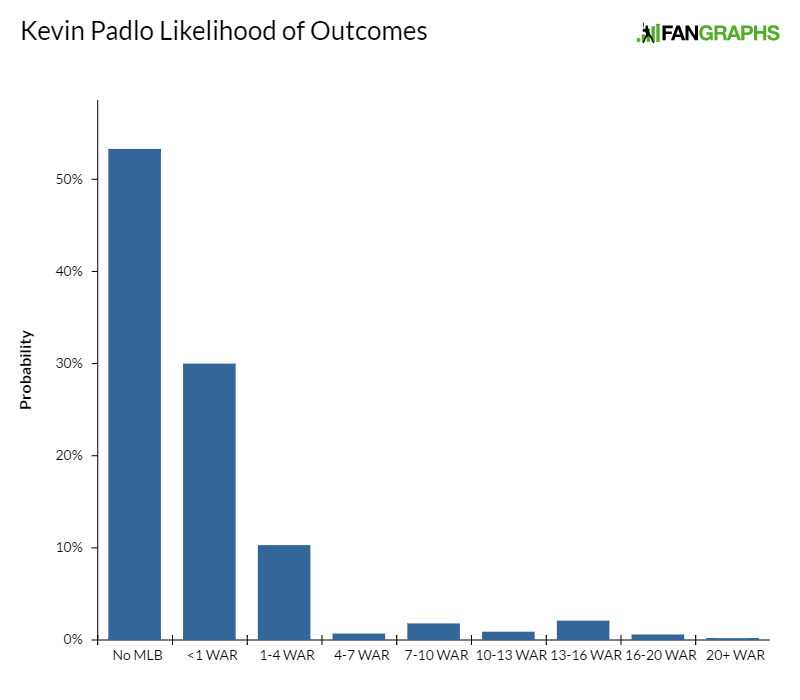
| Age | 24 | Height | 6’3 | Weight | 195 | Bat/Throw | R/R |
|---|
| Fastball | Curveball | Changeup | Command |
|---|---|---|---|
| 45/45 | 50/50 | 45/50 | 50/55 |
Relevant/Interesting Metrics
Has walked just under 6% of opposing batters as professional.
Scouting Report
Once a prototypical prep righty with a mid-90s fastball and hammer curve, Guerrieri has been sidetracked by Tommy John surgery and a 50-game drug suspension. A 2011 draftee, Guerrieri didn’t throw more than 80 innings in a season until last year; ironically, it’s the year his stuff backed up. He now sits 87-91 with a sinking fastball. There just isn’t as much arm acceleration here as there used to be, and the curveball is lacking the same depth and bite that once made Guerrieri such a desirable prospect, now profiling closer to average. He throws strikes, though, and might still carve out a spot at the very back of a rotation as a sinker/command arm. He’s on the precipice of the big leagues and projects as a fifth starter.
KATOH+ Projection for first six years: 0.8 WAR
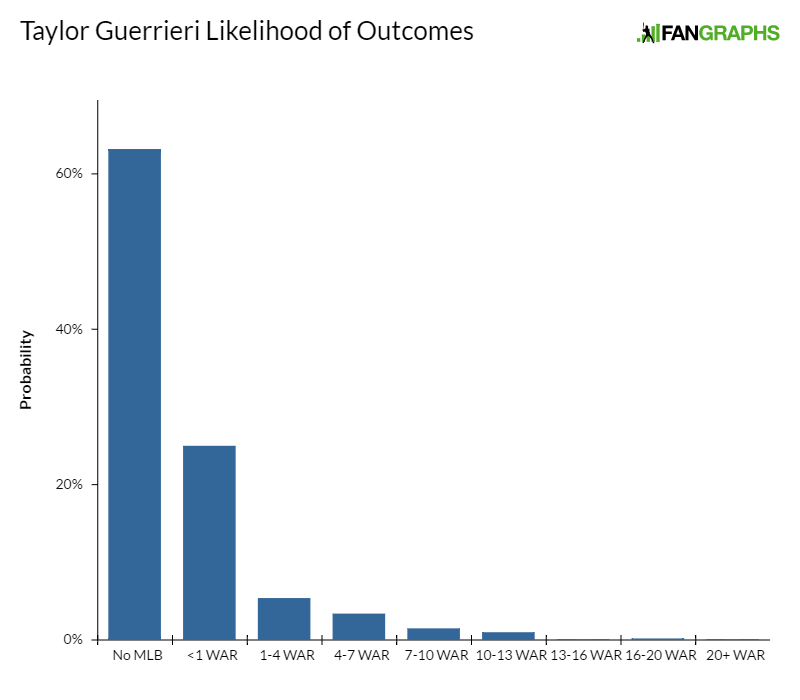
| Age | 23 | Height | 6’1 | Weight | 171 | Bat/Throw | R/R |
|---|
| Fastball | Curveball | Changeup | Cutter | Command |
|---|---|---|---|---|
| 45/45 | 45/45 | 40/45 | 55/55 | 55/60 |
Relevant/Interesting Metrics
Produced 24% strikeout rate at Double-A.
Scouting Report
Twiggy and bearded, Wood mitigates what might otherwise be a concerning lack of height with a vertical arm angle that creates downhill plane on his average, 91-94 mph fastball. He locates it down and to both sides of the plate consistently. His best secondary pitch is a mid-80s cutter with late movement and varied length and velo. He also works this pitch consistently his glove side, just off the plate, but he can back door it to lefties, as well. Wood’s repertoire sputters out after that. He has a below-average changeup and a big, loopy 66-70 mph curveball that is a neat little trick pitch but perhaps not a legitimate third offering. There’s dissent about Wood’s ability to pitch multiple times through a lineup with what is essentially a two-pitch mix and potential plus command, but he’s either going to be a fifth starter or uniquely constructed reliever, both of which are terrific outcomes for a 29th-round pick.
KATOH+ Projection for first six years: 1.2 WAR
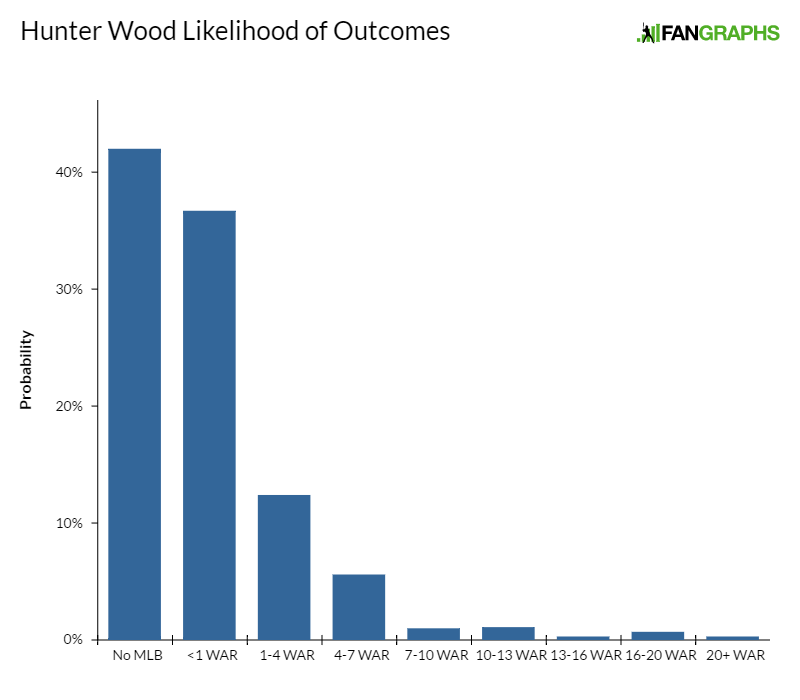
| Age | 26 | Height | 5’10 | Weight | 200 | Bat/Throw | R/R |
|---|
| Fastball | Curveball | Command |
|---|---|---|
| 60/60 | 60/60 | 40/40 |
Relevant/Interesting Metrics
Recorded 30% strikeout rate at Triple-A.
Scouting Report
Now 25 and still plagued by inconsistent control, Schultz projects to the bullpen, where his 91-97 mph fastball and power low-80s curveball will both miss bats. Schultz’s delivery is stiff and upright, which hinders his command in general and causes some of his pitches to sail way up out of the zone when he’s not finishing out over his front leg. It’s setup stuff, but middle-relief command.
KATOH+ Projection for first six years: 2.0 WAR
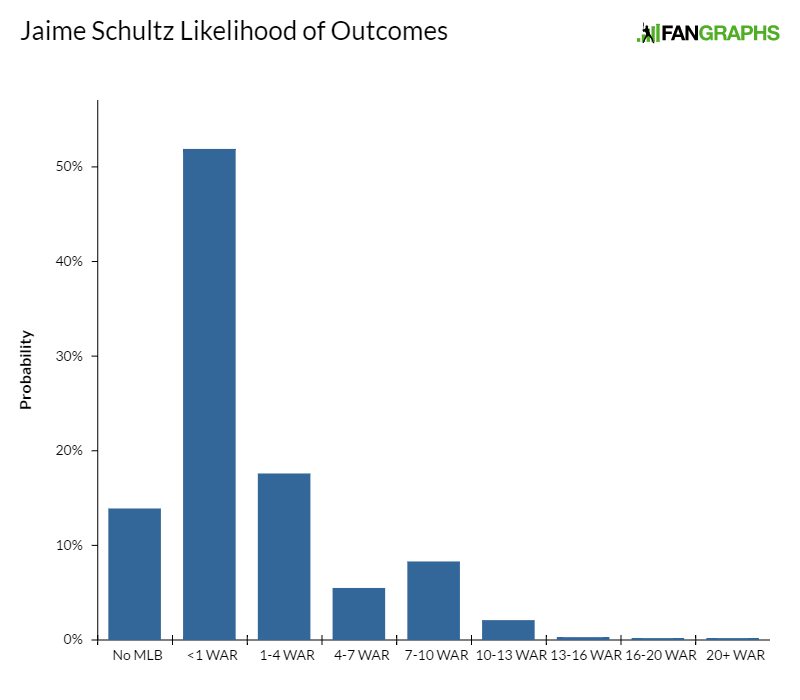
| Age | 22 | Height | 6’2 | Weight | 175 | Bat/Throw | R/R |
|---|
| Fastball | Curveball | Changeup | Cutter | Command |
|---|---|---|---|---|
| 55/55 | 40/45 | 55/60 | 50/50 | 40/45 |
Relevant/Interesting Metrics
Recorded average fastball velocity of 95 mph (in home games) AFL.
Scouting Report
Harris, who was acquired from Los Angeles for Joel Peralta, has had bat-missing success through High-A, and if he can tighten up his command, there’s a chance he makes it as a starter. He was 92-96 for me in the Fall League with an above-average mid-80s changeup that he sells well with good arm speed. He also has an average cutter, 83-86, as well as a curveball that I didn’t see in my AFL looks. It’s back-end-starter stuff but Harris has an awkward delivery, causing pitches to sail on him, and I’m skeptical about him having starter’s command. It should at least work in relief, though, and Harris is a likely big leaguer of some kind.
KATOH+ Projection for first six years: 1.7 WAR

| Age | 21 | Height | 5’11 | Weight | 200 | Bat/Throw | R/R |
|---|
| Hit | Raw Power | Game Power | Run | Fielding | Throw |
|---|---|---|---|---|---|
| 30/50 | 40/45 | 20/40 | 30/20 | 40/50 | 60/60 |
Relevant/Interesting Metrics
Posted 56% caught-stealing rate in 2016.
Scouting Report
Rodriguez was signed for $600K out of Venezuela in 2012 and was viewed at the time as a hit-before-power catching prospect with an above-average arm and solid chance to stay behind the plate. Rodriguez’s workload has increased as he’s moved into full-season ball and it’s taken a toll on his offensive output, though he still has solid bat-to-ball skills and doubles power. His value is now mostly tied into his defense, which is promising and exciting in some ways and still youthfully frustrating in others. He has plus raw arm strength and is sufficiently mobile, but he’s heavy handed and an immature game caller. The physical traits to catch long term are here, and it’s reasonable to expect Rodriguez to at least grow into a backup role. If he can return to hitting like he did in his first two pro seasons, he might carve out a regular role.
KATOH+ Projection for first six years: 1.1 WAR
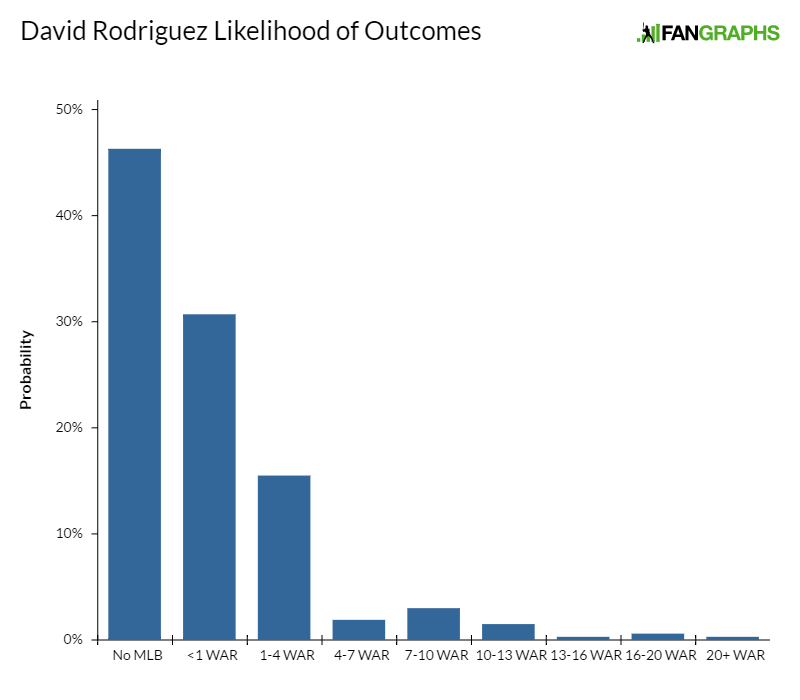
| Age | 22 | Height | 6’0 | Weight | 180 | Bat/Throw | L/L |
|---|
| Fastball | Curveball | Command |
|---|---|---|
| 70/70 | 60/60 | 30/40 |
Relevant/Interesting Metrics
Walked 17% of opposing batters in 2016.
Scouting Report
Still just 21, Alvarado has monster stuff from the left side with a 95-99 mph fastball and comfortably plus curveball. It’s a late-inning two pitch combo, but Alvarado has potentially fatal command issues. He was added to the 40-man over the winter and could debut this year if he can throw even a passable ratio of strikes.
KATOH+ Projection for first six years: 0.5 WAR

| Age | 23 | Height | 6’1 | Weight | 205 | Bat/Throw | R/R |
|---|
| Fastball | Slider | Command |
|---|---|---|
| 60/60 | 60/60 | 40/45 |
Relevant/Interesting Metrics
None.
Scouting Report
A potentially quick-moving relief prospect, Koch struck out 15 hitters per nine as a sophomore and junior at DBU and was drafted in the 2015’s fourth round. He throws hard, 94-97, and has a late-breaking, upper-80s slider that misses lots of bats. Both offerings play up due to the deception in Koch’s delivery. Inherent in that deception, however, is effort and violence (not dissimilar to Luke Gregerson’s current delivery) that hinders his control and gives some pause about his ability to stay healthy. He missed most all of 2016 due to injury. He’s a potential setup man if he can stay healthy and get ahead of hitters more consistently.
| Age | 22 | Height | 6’2 | Weight | 210 | Bat/Throw | L/R |
|---|
| Hit | Raw Power | Game Power | Run | Fielding | Throw |
|---|---|---|---|---|---|
| 35/50 | 50/50 | 30/40 | 55/50 | 40/45 | 40/40 |
Relevant/Interesting Metrics
OPS by year at Nebraska: .819 (2014), .837 (2015), .760 (2016).
Scouting Report
Boldt was a potential first-rounder in high school, a rare power/speed prep bat in the Midwest, but tore a meniscus as a senior and his stock fell beyond where he was willing to sign. He matriculated to Nebraska. I saw him as a freshman there and thought he looked like a first-round prospect. His body has gone backwards since then. Boldt has filled out considerably, and there’s some doubt about his long-term ability to stay in center field. His swing is geared for ground balls, and there are mechanical issues (a high, deep load, chiefly) that could make it hard for him to make corner-worthy levels of contact if/when he has to move. If Boldt can stay in center field, he’s a likely big leaguer whose role will be determined by how much he hits. If he can’t, it’s imperative that the quality of his contact improves. He was an interesting buy-low opportunity for Tampa in the draft.
| Age | 21 | Height | 6’0 | Weight | 205 | Bat/Throw | R/R |
|---|
| Fastball | Slider | Changeup | Command |
|---|---|---|---|
| 60/70 | 45/55 | 30/40 | 30/40 |
Relevant/Interesting Metrics
None.
Scouting Report
Acquired from Cleveland in the Brandon Guyer trade, Salinas is a huge, athletic-for-his-size righty with a great arm action and big fastball. He sits 92-97 with movement and has inconsistent feel for a slider and changeup. The slider, 77-80 in my look, is slurvy but is good when Salinas is keeping it down. He maintains his arm speed on an 83-87 mph changeup but has very little feel for its release right now.
The command is behind, not unusual for an arm this size with this kind of stuff, even at age 20. Salinas has been used as a starter so far but, unless you buy heavily into his athleticism and think he can develop much better control, he’s probably a future reliever. If his slider tightens and the fastball plays up out of the bullpen (as I have projected), he could be a dominant one.
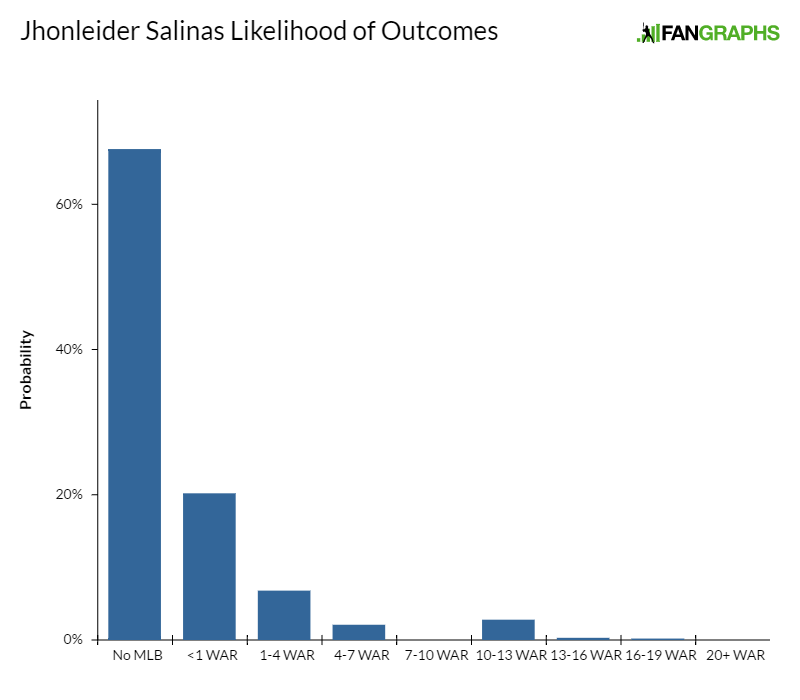
*****
*****
Other Prospects of Note (In Order of Preference)
Deivy Mendez, RHP – Mendez’s velocity has ticked up as his pro career has progressed. His fastball sat in the mid-80s when he signed in 2012 and then, by the end of 2014, it was regularly 93-94. When I saw him in the fall he was 96-98. But while Mendez’s velocity has progressed, his command has not; he’s still much more a thrower than he is a pitcher. He flashes an above-average change and slider, as well, and could be an impact reliever if he ever learns to harness his heat.
Austin Pruitt, RHP, 1.5 KATOH – Pruitt, who was a senior sign in 2013, turns 28 in August but has pitched well throughout the minors. He’s small (listed at 5-foot-11, 165 on Tampa’s roster) but an exceptional athlete with great command and a good curveball. He only throws 87-91, maybe touching 93 or 94 once in a while, with command to both sides of the plate. He’s adept at locating a mid-80s cutter to his glove side, away from righties, while his curveball is hard (for a guy who throws 88) and is totally vertical in the 77-81 mph range. He’s had a great spring and could impact the big club in some way this year.
Ryan Yarbrough, LHP, 1.1 KATOH+ WAR – A pitchability lefty acquired in the Drew Smyly trade, Yarbrough has mostly been 86-90 this spring, though at full speed, he’s 88—91 with an above-average changeup. His breaking ball is fringey and not all scouts like the delivery, but he throws strikes and neutralizes righties by consistently locating his changeup just off the plate. His fastball plays up against lefties due to his low arm slot. He projects as an up-and-down guy for me.
Genesis Cabrera, LHP, 1.0 KATOH+ – A quick-armed lefty, Cabrera was up to 95 for me in the fall and has some changeup feel. He displays significant mechanical variation, and I put a 30 on his breaking ball. He projects as a reliever for me right now, but there’s rare arm acceleration here for a lefty, and I think he could have an impact changeup one day.
Joe McCarthy, OF/1B, 2.0 KATOH+ – McCarthy has solid bat-to-ball skills and advanced on-base abilities that were polished during his long, successful tenure in Charlottesville. He’s limited, defensively, to first base and left field and doesn’t clearly possess the explosive power necessary to profile at those positions every day. He could make for a nice bench bat or platoon option. There’s a back injury (part of why he fell to round five in 2015) adding to the risk here.
Jake Hager, INF, 0.6 KATOH+ – Hager missed all of 2015 with a knee injury (through which he played in 2014), came back last year, and began expanding his defensive horizons by seeing his first game action at second and third base. Defensive versatility is his best hope at a long-term big-league role, as his bat is quite light. He’s 24 now and still not on the 40-man.
Rene Pinto, C – Another of several interesting catching prospects in this system (which is odd considering the seemingly perpetual issues the big club has behind the plate), Pinto is a solid receiver with a loose swing. The bat speed is fringey and the body is mature, but he’s at least a potential backup at this point.
Eleardo Cabrera, OF, 0.0 KATOH+ – A toolsy outfielder with a long, handsy swing that causes excessive swing and miss, Cabrera has a 7 arm and is a 55 runner who plays good corner-outfield defense. He has bat speed but needs significant mechanical work.
Christian Fernandez, RHP – Pretty standard Latin American starting pitching prospect here. Projectable frame for a 17-year-old (and he doesn’t turn 18 until August) at 6-foot-2, 170 and he should add to his currently 87-91 mph fastball as he matures. The delivery is smooth and there’s some nascent breaking-ball feel. That’s pretty much all you can ask for from an arm that pitched all of last year at age 16.
Vidal Brujan, 2B, 1.7 KATOH+ – Though he’s listed at a damningly small 5-foot-9, Brujan is long-limbed, rangy, and actually has some modest physical projection. He’s a plus runner with athletic defensive footwork and plenty of arm strength for second base. Some think he might even be able to pass on the other side of the bag eventually. He’s a switch-hitter with viable swings from both sides of the plate (though his right-handed swing looks like it will eventually be the more threatening one), he tracks pitches well, and has good bat control. It might take a positional change (to shortstop, if he truly can play there, so the bat can profile) or at least some defensive versatility, but there’s a potential big leaguer here.
Carlos Vargas, INF – Vargas came over in the Smyly deal. He spent 2016 year in the DSL and showed a precocious ability to take a walk there. He’s got a big, lean, projectable body and projects to third base. He already has some pull power and his raw power projection is quite significant given that his 6-foot-3, 170-pound build doesn’t turn 18 until mid-March. He showed a consistent ability to drive the ball in the air during showcases in the Dominican before he signed.
Luis Moncada, LHP – Moncada has outgrown his listed 6-foot-1 and is now about 6-foot-4 with a fastball that’s touching 94 and some slider feel. He turned 19 in February.
Pedro Diaz, RF – Diaz mashed as a 17-year-old in the DSL last year. It’s a corner-only profile, but there’s strength and power here to make it work and enough athleticism and feel to hit that he might get to it in games.
Jake Cronenworth, UTIL, 1.4 KATOH+ – Lots of teams were on Cronenworth as a three-pitch relief prospect at Michigan (as was I), where he’d sit 91-94 with an average splitter and fringe slider. It’s not explosive stuff, certainly not compared to most relievers, but it was an unusually deep repertoire for a reliever and Cronenworth was a good athlete who might harness better command when pitching full time. He also played first, second, and third base at Michigan, and sometimes a couple of those in a single game before coming in to close.
Tampa liked Cronenworth’s bat, loved his approach, and thought he could pass at second base. He has hit well in pro ball thus far and the club has moved him, full time, to shortstop, where his range and actions aren’t consensus fits.
Cronenworth has excellent hand-eye coordination, bat control, and feel for the strike zone. He has a contact-oriented approach and modest bat speed, so there’s not much power to speak of, even less than is typical for a shortstop (assuming he works out there). But while it’s unreasonable to expect Cronenworth to maintain his nearly .400 career pro OBP, his track record of reaching base is strong enough that, even as upper-level pitchers attack him because he lacks power, he could still reach base at an above-average clip. If he can do that and play a viable shortstop, he has a big-league future as a utility man. If not, perhaps there’s a Bethancourtian experiment looming somewhere down the line.
Blake Bivens, RHP, 1.4 KATOH+ – Bivens was Tampa’s fourth rounder in 2014. He has an average fastball/curveball combination that he delivers from a vertical arm slot. He has trouble getting over his front side and working down in the zone, or in it at all. He’s got a strong, durable build but likely winds up as a two-pitch reliever.
Adrian Navas, RHP, 0.7 KATOH+ – A 20-year-old Venezuelan righty, Navas is sturdily built and lacks physical projection but has viable stuff, with a low-90s fastball that will bump 94 and terrific changeup feel. He already has a TJ under his belt and his breaking ball is slurvy, but the change has plus projection and arms like this have had success in this system.
Nick Ciuffo, C, 0.7 KATOH+ – Ciuffo’s career has gotten back on track since a 2014 virus wreaked havoc on his body. He’s a square 220 or so now, but he’s retained the pleasing aspects of his defensive profile that have scouts on him despite horrendous career-long offensive output. He’s a good receiver with an above-average arm and is sneakily agile. While Ciuffo is a viable defensive catching prospect and actually has solid bat speed, his approach is very swing-happy and he may not even reach base enough to profile as a backup. He’s more of a third catcher than a big-league mainstay for me.
Kevin Gadea, RHP, 3.5 KATOH+ – A converted third baseman who, at 6-foot-5, was too big to do anything but pitch, Gadea was Tampa’s Rule 5 pick in December. He’s a fastball/changeup reliever who had not pitched above Rookie-level ball until last year. He sits 92-95 with an above-average changeup. He’s on the shelf with elbow tendinitis for at least a month, which is good for his chances of sticking with Tampa, I suppose, but not good for his prospect status in general.
Emilio Gustave, OF, 0.0 KATOH+ – Gustave missed a year due to a suspension for identity falsification but is a 60 runner with a 7 arm and good bat speed. He’s raw and is already 22 but yet to play above Rookie ball.
Patrick Leonard, UTIL, o.5 KATOH+ – Leonard has big raw power but is limited to the corner spots and he doesn’t track pitches well, which leads to lots of swinging and missing. He has a four-corner bench-bat ceiling.
Elias Torres, RHP – A converted outfielder, Torres’ fastball will touch 95 and he has some breaking-ball feel. Both pitches play up against righties due to some deceptive funk in Torres’ delivery. His command is very raw, but he hasn’t been pitching for very long. If he suddenly learns how to locate, he could move quickly.
Peter Bayer, RHP – I saw Bayer when he was a freshman at Richmond and he was 87-90 with some breaking-ball feel and physical projection. But his career there stalled and, after three years, he transferred to Cal Poly Pomona. He also began weighted-ball training at Driveline and started throwing a lot harder, 91-96. He struck out 103 hitters in 65.2 innings at Pomona but walked 40 hitters. He was drafted in the nint round, signed, and pitched 32 innings in the Appy League, walking just three with a similar K rate. He’s worth monitoring.
Brandon Lowe, 2B, 0.3 KATOH+ – A bat-to-ball second baseman, Lowe hit well at Maryland for two years but some of his mobility has been robbed by lower-body injuries (torn PCL as a freshman at Maryland, fractured fibula at the end of his R-Soph year that caused him to miss his pro debut). He has good ball/strike recognition but will need to hit a ton to profile.
Ronaldo Hernandez, C – A converted Colombian infielder who missed most of 2015 due to injury, Hernandez has interesting bat-to-ball skills and lots of defensive projection because he’s so new to catching. He hit .340 in the DSL last year at age 18.
Kenny Rosenberg, LHP – Like Giants prospect Jordan Johnson, Rosenberg entered his draft spring coming off of a lost year due to injury. He sits in the low 90s with a big, goofy curveball that plays up in relief.
David Olmedo-Barrera, OF, 1.7 KATOH+ – Olmedo-Barrera had rare power for a college bat (I had a 55 on the power while he was at Cal State Fullerton) and he pulls the ball in the air fairly consistently, but he has no position and is a fringey defender in left field.
Moises Gomez, OF – Gomez beat up on the DSL in 2015 but struggled in the GCL last year. He has intriguing raw power for an 18-year old, but his body is already maxed out and his bat isn’t in the hitting zone for very long.
Oscar Rojas, OF, 0.4 KATOH+ – A slightly built, 20-year-old Venezuelan outfielder, Rojas has good bat control and hand-eye coordination but Ks a lot because his swing is very long, his load quite deep. He’s a 55 runner. If he can make more consistent contact, he could be a bench outfielder.
Justin O’Conner – Once an elite defensive catching prospect, O’Connor was DFA’d over the winter and required multiple back surgeries, the latest of several injuries with which he’s dealt as a pro.
Selected by Carson Cistulli from any player who received less than a 40 FV.
Michael Russell, 1B/SS (?), 1.5 KATOH+
Russell split most of his time defensively last year between first base (41 starts) and shortstop (38), which isn’t really a thing that ever happens — except, for example, in the case of a player who’s recovering from an arm injury and plays first as part of his rehab. A cursory investigation reveals no evidence of such an injury, however. What it does reveal is that Russell both (a) is listed at 6-foot-2, 200 pounds (i.e. is large) and (b) possesses what might best be characterized as “unusual” actions.
Perhaps the actions only seem unusual because of the very positive results they’ve somehow produced. In 172 professional games, for example — or roughly the equivalent of a full major-league season — Russell has recorded a 51-for-60 stolen-base record. He’s also posted reasonable defensive numbers according to the methodologies employed both by Baseball Prospectus and Clay Davenport.
None of this acknowledges his greatest asset — namely, his bat. Russell struck out in just 14.0% of his plate appearances in the Midwest League last year in a league that featured a 21.7% strikeout rate overall. It seems relevant to note that he acknowledges having rebuilt his swing between his sophomore and junior seasons after studying video of Jose Bautista. It seems relevant to note a lot else about this weird, great player.
*****
System Overview
This system has pitching prospects with arm strength and pitching prospects with changeups. The ones with both are at the top of the list. An overarching theme in the system seems to be age. The club has targeted hitters who are having success and are young relative to their level (such as Bauers, Williams and Adames) in trades but slow cooks their own prospects, advancing them through the minors very slowly. This system also has several potential big-league catchers, which is something the club has needed for a while. Tampa is likely to add a high-end prospect in June’s draft (they pick fourth) and is also expected to acquire high-profile talents from Latin America in July. Already rife with raw but toolsy, dream-inducing prospects, this club is a trade, draft and July 2nd away from having one of the more interesting and entertaining systems in baseball.
Eric Longenhagen is from Catasauqua, PA and currently lives in Tempe, AZ. He spent four years working for the Phillies Triple-A affiliate, two with Baseball Info Solutions and two contributing to prospect coverage at ESPN.com. Previous work can also be found at Sports On Earth, CrashburnAlley and Prospect Insider.
There’s been some commentary about Tampa Bay’s “cult of the high fastball” and their obsession with outfield defense. Some commenter mentioned that as long as they’re at it, they might as well punt infield defense as well and make their market inefficiencies fit together. It seems like they think that we’re all overrating the physical characteristics needed for shortstop, although whether it’s related to their high-fastball philosophy isn’t clear.
My take on it is that the Rays just think they can “shift their way” around having middle infielders with average to below-average range.